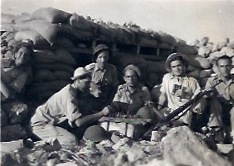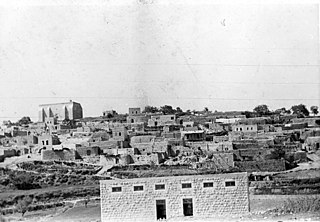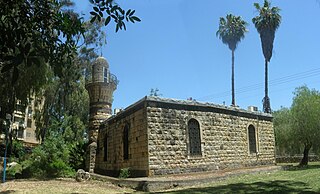Related Research Articles

The 1948 Arab–Israeli War, also known as the First Arab–Israeli War, followed the civil war in Mandatory Palestine as the second and final stage of the 1948 Palestine war. The civil war became a war of separate states with the Israeli Declaration of Independence on 14 May 1948, the end of the British Mandate for Palestine at midnight, and the entry of a military coalition of Arab states into the territory of Mandatory Palestine the following morning. The war formally ended with the 1949 Armistice Agreements which established the Green Line.

Iqrit was a Palestinian Christian village, located 25 kilometres northeast of Acre. Originally allotted to form part of an Arab state under the proposed 1947 UN Partition Plan, it was seized and depopulated by the Israel Defense Forces (IDF) during the 1948 Arab–Israeli War, and their territory later became part of the new State of Israel. All of its Christian inhabitants were forced to flee to Lebanon or the Israeli village of Rameh, and, despite the promise that they would be returned in two weeks' time, the villagers were not allowed to return. In 1951, in response to a plea from the Iqrit villagers, the Israel Supreme Court ruled that the former residents of Iqrit be allowed to return to their homes. However, before that happened, the IDF, despite awareness of the Supreme Court decision, destroyed Iqrit. Descendants of the villagers maintain an outpost in the village church, and bury their dead in its cemetery. All attempts to cultivate its lands are uprooted by the Israel Lands Administration.

Kafr ʿInān, is a former Palestinian village, depopulated in the 1948 Arab–Israeli war. It was located around 33 kilometres (21 mi) east of Acre.

Operation Hiram was a military operation conducted by the Israel Defense Forces (IDF) during the 1948 Arab-Israeli War. It was led by General Moshe Carmel, and aimed at capturing the Upper Galilee region from the Arab Liberation Army (ALA) forces led by Fawzi al-Qawuqji and a Syrian battalion. The operation, which lasted 60 hours, was marked by heavy fighting between Arabs and Jews, and ended just before the ceasefire with the neighboring Arab countries went into effect.

Killings and massacres during the 1948 Palestine war resulted in the deaths of hundreds of civilians and unarmed soldiers.
The al-Dawayima massacre describes the killing of civilians by the Israeli army (IDF) that took place in the Palestinian Arab town of al-Dawayima on October 29, 1948, during the 1948 Arab–Israeli War. The incident occurred after the town was occupied by the IDF's 89th Commando Battalion during Operation Yoav, encountering little resistance. The battalion was composed of former Irgun and Lehi forces.
The al-Kabri incident, also known as the al-Kabri massacre, was a military operation carried out by the Israeli army during the 1948 Arab–Israeli War in retaliation for the ambush of the Yehiam convoy. Two months following the ambush, the commander of Operation Ben-Ami gave operational orders given that day were to "attack with the aim of capturing, the villages of Kabri, Umm al Faraj and Al-Nahr, to kill the men [and] to destroy and set fire to the villages." Benvenisti states that "the orders were carried out to the letter", while Morris writes that a number of villagers were apparently executed. On May 20, 1948, the Israeli Carmeli Brigade captured al-Kabri, a Palestinian Arab village in the northwest corner of the region of the British Mandate of Palestine that was later incorporated into the State of Israel. Al-Kabri was captured without any resistance and it was almost immediately depopulated. It was treated particularly harshly due to the villagers involvement with the destruction of the Jewish convoy. According to Walid Khalidi, an 'undisclosed number of villagers were taken prisoner and some were killed' and others were killed during their dispersal in Galilee when it was discovered that they had come from al-Kabri.

Safsaf was a Palestinian village 9 kilometres northwest of Safed, present-day Israel. Its villagers fled to Lebanon after the Safsaf massacre in October 1948, during the 1948 Arab–Israeli War.

The Kfar Etzion massacre refers to a massacre of Jews that took place after a two-day battle in which Jewish Kibbutz residents and Haganah militia defended Kfar Etzion from a combined force of the Arab Legion and local Arab men on May 13, 1948, the day before the Israeli Declaration of Independence. Of the 127 Haganah fighters and Jewish kibbutzniks who died during the defence of the settlement, Martin Gilbert states that fifteen were killed on surrendering.

The Ein al Zeitun massacre occurred on May 1, 1948, during the 1948 War, at the Palestinian Arab village of Ein al-Zeitun just north of Safed, then part of the British Mandate for Palestine. According to various historians, 23-70 Arab prisoners were killed by the Palmach.

Al-Khalisa was a Palestinian Arab village situated on a low hill on the northwestern edge of the Hula Valley of over 1,800 located 28 kilometers (17 mi) north of Safad. It was depopulated in the 1948 Palestine war.

In February 1948, Yigal Allon, commander of the Palmach in the north, ordered an attack on Sa'sa'. The order was given to Moshe Kelman, the deputy commander of Third Battalion. The order read: "You have to blow up twenty houses and kill as many warriors as possible". According to Ilan Pappé, "warriors" should be read as "villagers" to properly understand the order. Khalidi, referencing "The History of the Haganah" by Ben-Zion Dinur, say they referred to the massacre as "one of the most daring raids into enemy territory."
During the 1948 Palestine war in which the State of Israel was established, around 700,000 Palestinian Arabs or 85% of the total population of the territory Israel captured fled or were expelled from their homes by Israeli forces. The causes for this mass displacement is a matter of great controversy among historians, journalists, and commentators.
The Eilabun massacre was committed by soldiers of Israel Defense Forces during Operation Hiram on 30 October 1948. A total of 14 men from the Arab Christian village of Eilabun (Eilaboun) were killed, 12 of them executed by the Israeli forces after the village had surrendered. The remaining villagers were expelled to Lebanon, living as refugees for some months before being allowed to return in 1949 as part of an agreement between the state of Israel and Archbishop Maximos V Hakim.

Saliha, sometimes transliterated Salha, meaning 'the good/healthy place', was a Palestinian Arab village located 12 kilometres northwest of Safed.

The Tantura massacre took place on the night of 22–23 May 1948 during the 1948 Arab–Israeli War. Around 40–200 Palestinian Arab villagers from Tantura were massacred by the Alexandroni Brigade, which was part of what became the Israeli Defense Force. The massacre occurred following Tantura's surrender, a village of roughly 1,500 people in 1945 located near Haifa. The victims were buried in a mass grave, which today serves as a car park for the nearby Tel Dor beach.

The 1948 Palestinian expulsion from Lydda and Ramle, was the expulsion of 50,000 to 70,000 Palestinian Arabs when Israeli troops captured the towns in July that year. The military action occurred within the context of the 1948 Arab–Israeli War. The operation included the events of the Lydda Massacre and the Lydda Death March. The two Arab towns, lying outside the area designated for a Jewish state in the UN Partition Plan of 1947, and inside the area set aside for an Arab state in Palestine, were subsequently transformed into predominantly Jewish areas in the new State of Israel, known as Lod and Ramla.
Operation Shoter, also Operation Jaba', was a three-day Israeli operation during the 1948 Arab–Israeli War against an area called the "Little Triangle" south of Haifa. It was launched a week after the start of the second truce imposed by United Nations. The operation was carried out by units from the Golani, Carmeli and Alexandroni brigades with supporting troops, under the overall command of Alexandroni's 33rd Battalion. Arab forces consisted of local militia which was not part of any regular army. The objective of the operation was to clear the Tel Aviv – Haifa Road, which had been closed by the Arabs to Israeli traffic. The Israelis had been forced to take a long and dangerous route to the east through Wadi Milk.

Al-Hamma was a Palestinian Arab village in the Tiberias Subdistrict, 12 kilometres (7.5 mi) southeast of Tiberias. It was situated on a narrow salient in the Yarmouk Valley bounded by Syria to the north and Transjordan to the south and east. Al-Hamma was one of the stations on the Jezreel Valley railway, linking the Hejaz Railway to Haifa. It was depopulated twice, once in July 1949, and again between 1949 and 1956.

The Nakba was the ethnic cleansing of Palestinians in Mandatory Palestine during the 1948 Palestine war through their violent displacement and dispossession of land, property and belongings, along with the destruction of their society, culture, identity, political rights, and national aspirations. The term is also used to described the ongoing persecution and displacement of Palestinians by Israel. As a whole, it covers the shattering of Palestinian society and the long-running rejection of the right of return for Palestinian refugees and their descendants.
References
- Oral History interview with Mohammad Abdallah Edghaim
- Abu Ismail's eyewitness account
- Mohammad Abdallah Edghaim's eyewitness account
- Morris, Benny (1995). Falsifying the record: a fresh look at Zionist documentation of 1948, Journal of Palestine Studies , 24: 44–62.
- Morris, Benny (2004). The Birth of the Palestinian Refugee Problem Revisited. Cambridge University Press. ISBN 0-521-00967-7.
- Morris, Benny (2008). 1948: The First Arab-Israeli War. Yale University Press.
- Nazzal, Naffez (1978). The Palestinian Exodus from Galilee: 1947–1949. Inst. Pal. Studies.
- Zertal, Idith (2005). Israel's Holocaust and the Politics of Nationhood. Cambridge: Cambridge University Press. ISBN 0-521-85096-7.
